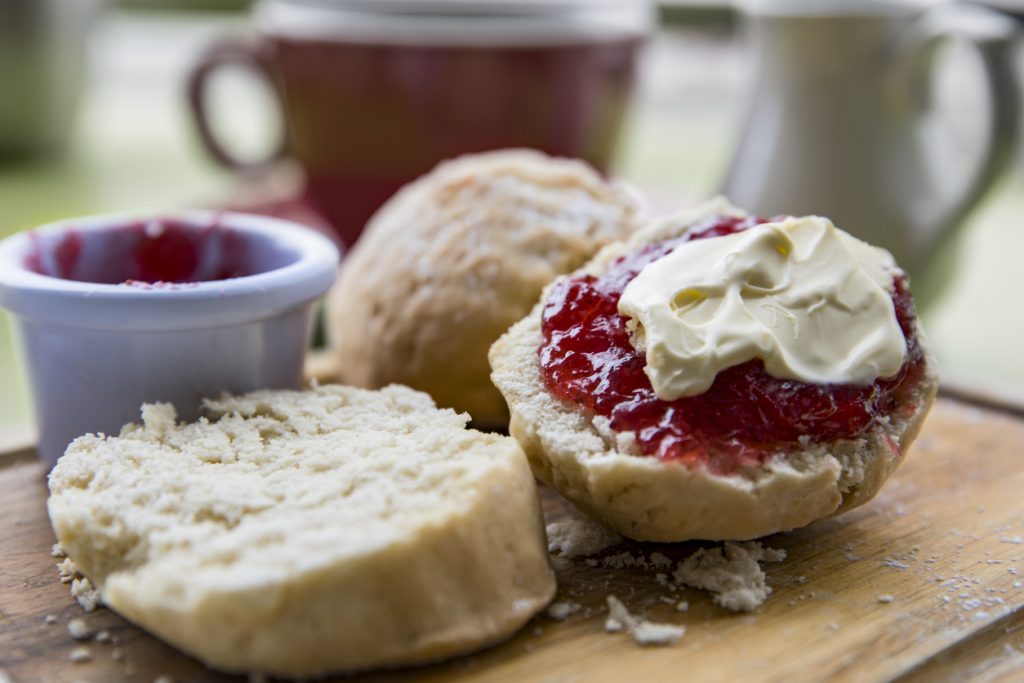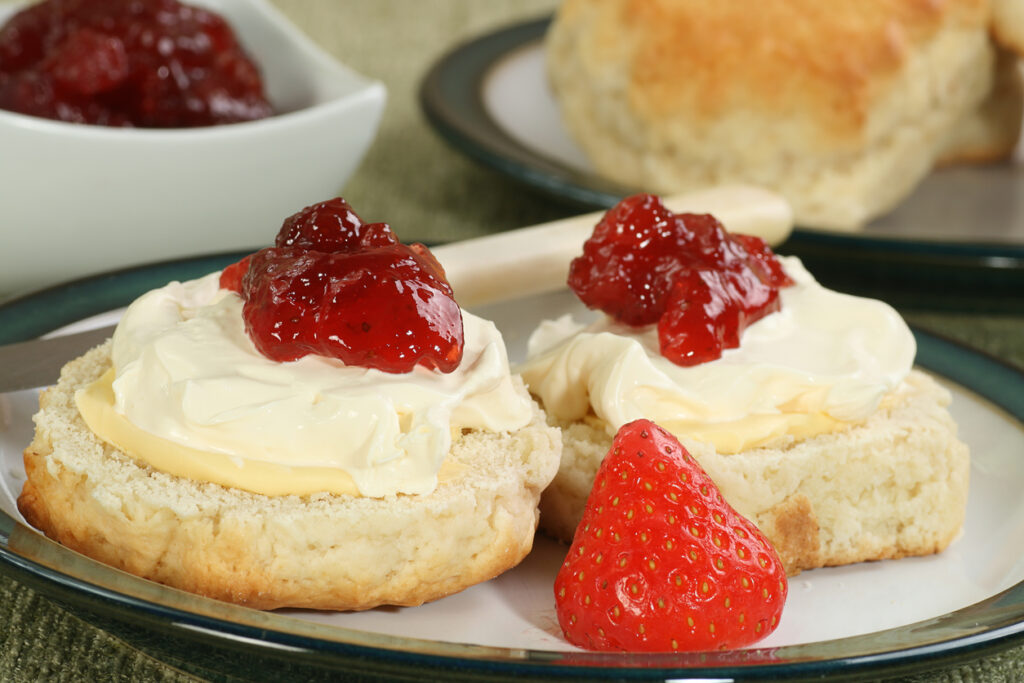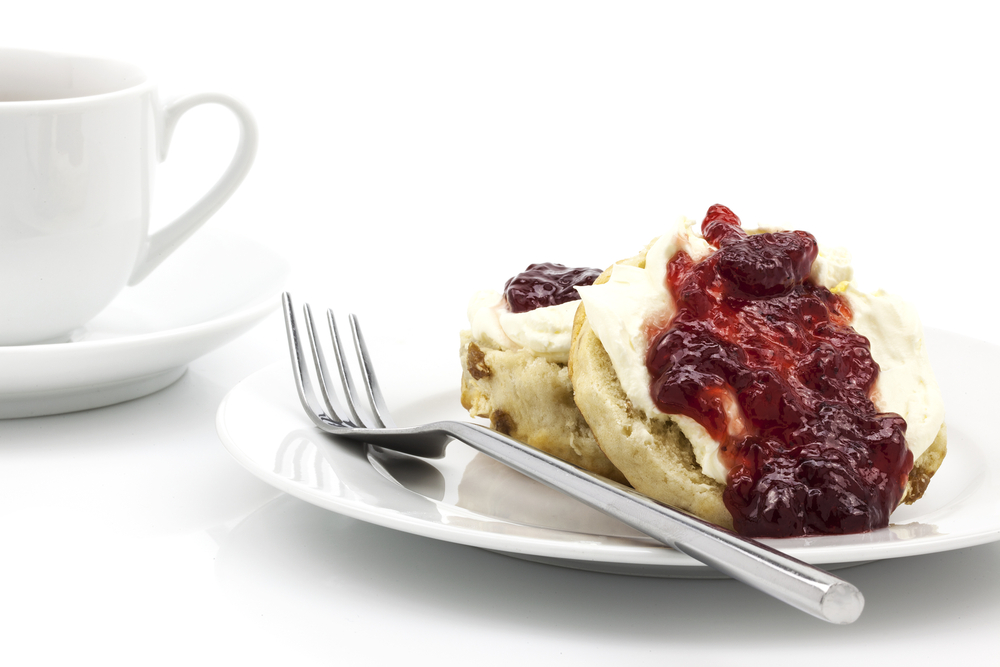How to eat a scone: cream or jam first?
It’s the ultimate West Country dilemma – should you put cream or jam on a scone first?
This question divides tea tables across the country, each side staunchly defending their method with a zeal usually reserved for sports rivalries.
In Devon, cream reigns supreme as the first layer, while in Cornwall, jam holds the fort.
Personally, I’m neutral – I live in Devon, but my heritage is Cornish, so I just make up my scones depending on which county I’m in!
But, lots of people feel much more passionately about the topic. I took to my Facebook page to ask people’s opinions (thanks everyone for weighing in!), and I’ve attempted to summarise the main arguments in this article!
What is a cream tea?

A classic cream tea involves a combination of scones, clotted cream, and jam, accompanied by a pot of tea.
The scone serves as the base for a layer of jam and a dollop of cream.
Despite the ongoing debate over the order of these toppings, the essential components remain the same.
A brief history of cream tea

The origins of the cream tea can be traced back to the 11th century in Devon and Cornwall.
Monks at Tavistock Abbey in Devon are credited with one of the earliest forms of this tradition (does this give weight to the idea of cream first?). They served bread with clotted cream and jam to labourers who helped rebuild the abbey after a Viking raid.
Over the centuries, regional variations developed. In Devon, the tradition dictates cream first, then jam, while in Cornwall, it is jam followed by cream. Each region claims its method enhances the taste and texture of the scone.
By the 19th century, the cream tea had become a symbol of leisure and hospitality in the English countryside, often associated with tourism and leisurely afternoons.
Today, the cream tea holds a place of affection in British hearts, often featured in cafes and hotels across the UK.
The cream tea not only continues to be a focal point for regional pride but also attracts tourists eager to partake in this quintessentially British tradition.
The British cream tea has also found its way into the global tea culture, with variations and adaptations appearing in tea rooms worldwide.
The argument for cream first
When it comes to dressing a freshly baked scone, those in the cream-first camp have a handful of compelling reasons to lay down a thick layer of clotted cream before topping it off with a dollop of jam.
Many argue that it takes the place of butter, and butter would logically go first on bread or a cake, so it makes sense that it’s spread first on the scone.
Another point is that the eater tastes the cream first, a flavour which is then enhanced by the jam’s sweetness.
Anne Holbrook even summarised that “If you use, as you should, proper thick clotted cream, it needs a firm surface to be spread. If it is put onto the jam it will just sit there in blobs or fall off. I can only surmise that Cornish clotted cream is inferior to our Devon variety!”
And then, of course, there’s the argument of tradition – it’s just how it’s done in Devon. This is why I always eat my cream teas this way round when I’m this side of the Tamar!
The argument for jam first
For those who advocate spreading jam on their scones before topping them with a dollop of cream, their arguments are just as passionate and practical as their Devon counterparts!
One of the main arguments for jam first is that it spreads easier, and Alex Withey summarises “The scone is warm having recently come out the oven, so you put jam on first, if you put the cream on first it would melt and the scone would be a soggy mess”.
Plus, if you’re planning on dolloping the cream, then it wouldn’t make much sense to put the cream first. Some people argue that the jam is more challenging to spread on top of the cream – although some people in Devon argue the other way (and tend to spread the cream first).
Again, there’s the Cornish argument of tradition (which is why I put jam first when I’m in Cornwall!).
Interestingly, parts of Australia seem to have adopted the Cornish tradition, with one commenter mentioning that it’s usually jam first there (although others have mentioned that this isn’t the case everywhere in the country).
I’m guessing in some places in Australia, jam-first might be due the Cornish miners who emigrated to Australia during the Gold Rush?
Does it really matter?

Of course, along with many passionate cream or jam-first arguments, there are also plenty of neutral opinions.
Some commenters noted that people just do what their family or ancestors do, with other people noting that they think it still tastes the same either way.
One even summarised that it “doesn’t make a scrap of difference, just something for people to argue about!”
Then, there was the debate about butter. Should butter go on a scone? Largely, the opinion was NO, but one commenter was avid about the idea of butter with jam AND clotted cream!
So, cream or jam first?
In reality, we’re probably never going to settle this friendly debate. Just like one commenter, I have affiliations on both sides of the Tamar, so I’ll keep going cream first in Devon and jam first in Cornwall.
If you’re travelling to the West Country and aren’t sure what way round to eat your scones, I recommend doing the same!






